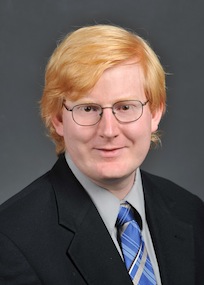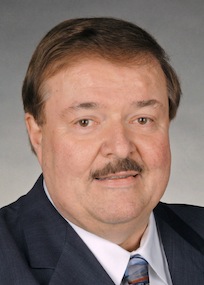Idaho State University RISE Complex ahead of schedule in wide range of research endeavors
October 23, 2012
The Idaho State University Research and Innovation in Science and Engineering (RISE) Complex is living up to its acronym ahead of schedule – rising as an ISU research enterprise, already attracting more than $5.7 million in research grants.
"We have a one-of-kind research facility, and we have some high-tech research equipment that you won't find anyplace else in the world," said Eric Burgett, ISU associate professor of nuclear engineering and principal investigator on the grants mentioned above.
 "The whole point of RISE," he continued, "is to put facilities together for multi-disciplinary research and collaboration. We're building a world-class facility."
"The whole point of RISE," he continued, "is to put facilities together for multi-disciplinary research and collaboration. We're building a world-class facility."
The RISE building, formerly the Ballard Building on Alvin Ricken Drive in Pocatello, was purchased by ISU in May 2011. Burgett received initial grants of $2 million in August 2011, and researchers didn't start moving into the building until November of last year.
"Less than a year ago this was a cold, empty warehouse, but we've accomplished an amazing amount since then," Burgett said. "We already have people from around the world wanting to visit and use the facilities we have in place. Most research centers take at least five years to get off the ground. We're way ahead of schedule."
Research at RISE varies from developing advanced radiation detectors and measuring fuel inside nuclear reactors to using electron accelerators to scan cargo containers. It can grow giant crystals to support nuclear science and engineering programs, and grow new and cutting-edge semiconductors. It also has its own prototyping shop, where researchers can manufacture their own parts and equipment at a highly precise, computer-controlled machine shop.
 "The RISE complex meets a definite need near the ISU campus for space for unique research facilities," said Richard Jacobsen, executive director for the ISU Office of Research and Technology Transfer. "As we involve both the private sector and other universities in our research programs along with the federal and state funding for national research priorities, it quickly becomes evident that additional space is needed for large scale programs and demonstrations. The ability to support applications related to economic development in the state and region is vital to the success of our research."
"The RISE complex meets a definite need near the ISU campus for space for unique research facilities," said Richard Jacobsen, executive director for the ISU Office of Research and Technology Transfer. "As we involve both the private sector and other universities in our research programs along with the federal and state funding for national research priorities, it quickly becomes evident that additional space is needed for large scale programs and demonstrations. The ability to support applications related to economic development in the state and region is vital to the success of our research."
The RISE Complex’s capabilities include a Nanotech Fabrication Laboratory, Applied Microscopy Laboratory, NanoRad Fabrication Laboratory, Crystal Growth Laboratory, Homeland Security Laboratory, Semiconductor Processing Laboratory, Wet Chemistry/Extraction Laboratory, Radio-Bio Safety Laboratory, High Power Laser/Optics Laboratory and an Imaging Laboratory and a Human Interactive Environment Simulation Laboratory.
The RISE Complex is also offering a wide-ranging educational experience for ISU students.
"This is an exciting place to be," Burgett said. "We have more than 40 undergraduate and graduate students, from the technician level up to Ph.D. candidates, working up here, assisting us in what we do."
The students come from a variety of backgrounds including computer science, electrical engineering, mechanical engineering, nuclear engineering, physics and College of Technology technical programs.
"Graduate students working on both doctoral and master's degrees in the science and engineering fields are the most likely current occupants of the RISE facility, but as we expand our programs in the health professions, we will see the need for unique spaces for biological research projects," Jacobsen said.
Major RISE projects include:
• NanoVision Project – This will develop small, radiation-resistant sensors to use within nuclear reactors.
• Atomisitc Fuel Performance Studies – Developing engineered materials to better understand nuclear fuel.
• Plasmonically cloaked neutron detector – This project should result in several advances for neutron detector research and nanotechnology fields.
• Single crystal growth project – This program is designed to create custom-engineered, single-crystal uranium dioxide samples.
• Cargo scanning research and capability verification – This is a joint ISU-Scan Teach project using an electron accelerator to scan cargo containers. The scan can determine shapes of items contained and container content.
• Nuclear fuels analysis.
• Radiobiological and Advanced Research with Infectious Diseases – This user facility will provide the means for groundbreaking medical and biological research.
• Advanced and Next Generation reactor software and simulation development.
• Neutronics – This research center will be a user facility providing numerous neutron sources of varied flux and energy for advanced research with neutrons.
"Our labs and the equipment in them have a wide-range of applications for a collaborations across disciplines," Burgett said, "and they been put together uniquely in the RISE Complex. The RISE Complex is an integrated part of ISU, fully integrated in the College of Science and Engineering and an integral member of the ISU Institute of Nuclear Science and Engineering."
"The leadership of Dr. Eric Burgett in materials science and nuclear and biological areas is recognized by others outside ISU, and this national attention is providing opportunities for our students to work in exciting new fields of research," Jacobsen said. "Similarly, the work of Dr. Alan Hunt and others in the Idaho Accelerator Center will inspire new projects that can locate in the RISE Complex."
###
Categories:
